The Ultimate Guide To Medicinal Mushrooms

Mushrooms as medicine is not a new concept.
In fact, medicinal mushrooms have been used by some cultures for centuries- revered for their ability to energize, to boost immunity, and to provide a foundation for overall health
And that’s just a start.
Today, people just like you are starting to discover how these functional mushrooms may help improve cognition and brain health, aid with getting better sleep, ease anxiety and stress, and even reduce allergies.
Mushrooms really are changing lives!
Medicinal mushrooms have also taken center stage at laboratories and clinics around the world, as more research is being done all the time to determine the science behind the reported benefits.
Adaptogenic Mushrooms
Whether we realize it or not, our bodies are faced with an onslaught of various stresses every single day.
For you, it might be a crazy schedule that keeps you from getting enough sleep. It might be having to power through the day at a high-stress job.
It could even be environmental stresses like seasonal weather changes, or toxic substances in the air you breathe every day.
Our bodies need to find ways to “adapt” to these stresses so that we can maintain our systems in healthy balance.
“Adaptogens” are a very special class of natural substances- including herbs, plants and, of course, mushrooms- that help us deal with these stresses in a non-specific way.
This means that they help give our body and mind exactly what it needs to adapt to the stress and get back into balance.
Certain mushrooms, such as Reishi and Cordyceps have a long history of use as adaptogens. Most people will use these mushrooms on a regular and consistent basis to get the full benefit as an adaptogen.
Mushrooms for Immunity
Our immune system really is the foundation for overall health.
If it’s underactive, we become susceptible to colds, flu, and other diseases.
On the other hand, if the immune response is overactive, we begin to attach our own bodies through inflammation and other more serious auto-immune disorders.
Either way, if your immune function gets out of balance, you’re going to have a bad time.
Perhaps the most well-known benefit of medicinal mushrooms is their ability to modulate the immune system. It’s a similar concept to an adaptogen- mushrooms can boost your immune system when it’s underperforming and dial it back when it gets out of control.
Basically, they can set your immunity to auto-pilot.
The reason this works is because key cells in our immune systems have a naturally strong affinity to fungal polysaccharides, small compounds found within the mushroom fruiting body.
History of Mushroom Use
In 1991, scientists discovered the body of an ancient man- mummified under ice on the border between Italy and Austria. He was later given the name “Otzi”, and was thought to have lived around 3300 BC.
Otzi was a traveller- and wouldn’t have wanted to burden himself by carrying anything unnecessary.
That’s why it is so interesting that among his few possessions were not one, but two species of mushrooms!
The first was Tinder Fungus (Fomes fomentarius), a mushroom traditionally used to help start fires – quite practical for an alpine traveler!
But the other mushroom found in his pouch was a Birch Polypore (Piptoprus betulinus)- a powerful medicinal mushroom known for its powerful anti-parasitic, anti-inflammatory and anti-biotic properties.
It’s very likely that Otzi was actually using this functional mushroom to rid himself of whipworm.
This shows that even 5000 years ago, people were aware of – and using- medicinal mushrooms.
This tradition has carried on throughout history, as many cultures around the world have a reputation of using medicinal mushrooms for therapeutic benefit.
Mushrooms are especially prevalent in Traditional Chinese Medicine, with uses of Reishi (known as ling-zhi) dating back 2000 years. Reishi is thought to the “Mushroom of Immortality”, and was once reserved only for royalty and emperors in ancient China.
China still plays a central role in bringing these amazing medicinal mushrooms to the world, and is where the vast majority of medicinal mushrooms are expertly grown.
Medicinal Mushroom Types
What’s the difference between medicinal mushrooms and edible mushrooms? Can some mushrooms be both?
It’s estimated that there are over 1.5 million species of fungi on planet earth. In fact, fungi are thought to account for about 25% of the world’s biomass!
However, only a small fraction of the total species are considered to have exceptional medicinal properties- and only a dozen or so species have been seriously researched for their benefits.
Without a doubt, getting the honor of being called a “medicinal mushroom” is a pretty high bar to pass.
So what are the benefits of medicinal mushrooms, and what mushrooms are special enough to make the cut? Let’s take a closer look.
1. Cordyceps (C. Sinensis and C. militaris)
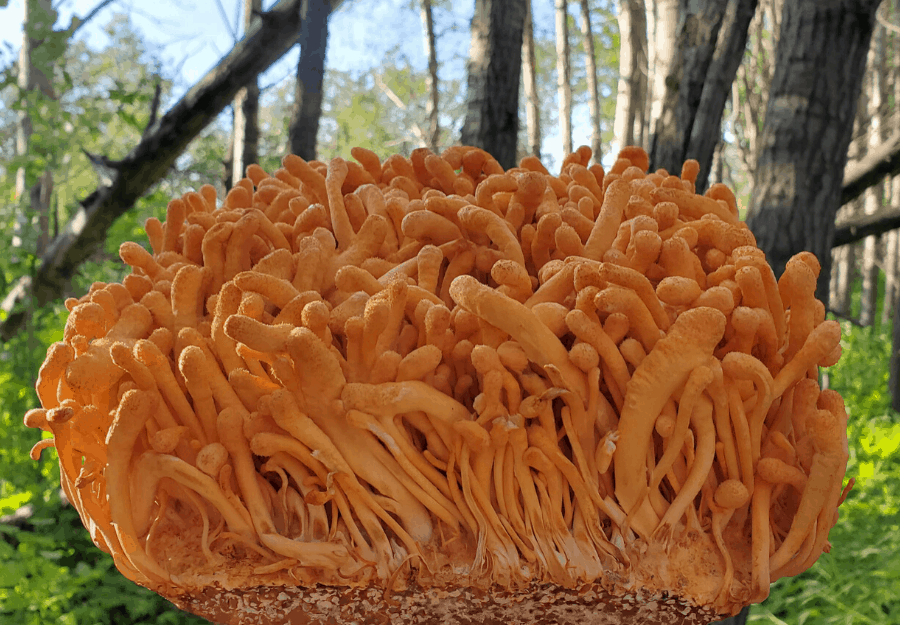
You can think of Cordyceps as the “Energy Mushroom”. People use Cordyceps for:
- Athletic Performance
- Increased energy and stamina
- Improved lung function (asthma and bronchitis)
- Sexual function
Ophiocordyceps sinensis is a species of Cordyceps that naturally grows high in the mountains of Tibet.
It also has an incredibly strange life cycle.
Spores from this mushroom will parasitize the brains of caterpillars, essentially turning them into little wriggling zombies. The caterpillars are compelled by the mushroom to travel to a suitable location, so they can die- and have a Cordyceps mushroom fruit through their head.
Luckily, humans aren’t affected in the same way, and don’t have to worry about turning into zombies. In fact, the effect that Cordyceps has on humans is quite the opposite, providing enhanced energy, endurance and athletic performance. (1)
C. sinensis, also known as the “caterpillar fungus”, absolutely needs to be grown on insects, and has evaded attempts at commercial cultivation. It absolutely needs to be found and foraged in the wild.
Unfortunately, it is extremely rare, and because of that, it’s also prohibitively expensive.
Luckily, there is a vegan friendly, insect-free version of Cordyceps known as Cordyceps militaris, that can easily be cultivated natural substrates. C. militaris has shown to have properties very similar to the highly sought-after C. sinensis, but at a fraction of the cost.
2. Reishi (Ganoderma lucidum)
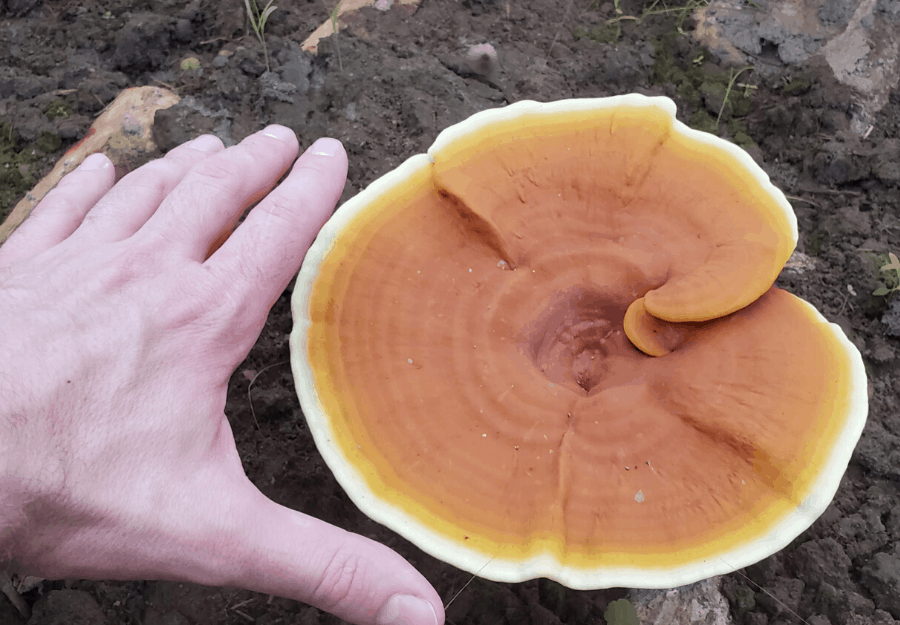
Reishi is known as the “Mushroom of Immortality”. People use this mushroom to help:
- Modulate the immune system
- Reduce the side effects of chemotherapy
- Improve energy and mental sharpness
- Reduce anxiety and get better sleep
Reishi grows naturally on the hardwood trees and stumps. When fresh, the fruiting body is stunningly red, and looks like someone just recently polished the surface. Fittingly, it’s also known as the “varnished conk”
Without a doubt, Reishi is one of the most fascinating, well studied, and well-known mushrooms in the entire world…. but definitely not for its taste.
In fact, if you were to go take a bite of this shiny mushroom in the woods, you’d probably spit it out-quick.
That’s because not only is Reishi extremely bitter, it also has a texture as tough as the wood it grows on. Luckily, the same compounds that make Reishi unfit for the kitchen also give it amazing medicinal properties.
One of the most common uses for Reishi is for reducing allergy symptoms. (3) Some allergy sufferers claim consistent use of this bitter-tasting fungus has allowed them to stop taking over the counter anti-histamine completely.
Reishi also has a calming effect, which is helpful for people suffering from anxiety and other forms of chronic stress. It can also be used as a mild sedative for people suffering from insomnia. (4)
Traditionally, Reishi is prepared by simmering the fruiting body of the mushroom in hot water for several hours, effectively making a strong flavored tea. You can also buy pre-extracted and encapsulated powders, which help get the benefits of Reishi without fighting through the bitter taste.
3. Maitake (Grifola frondosa)
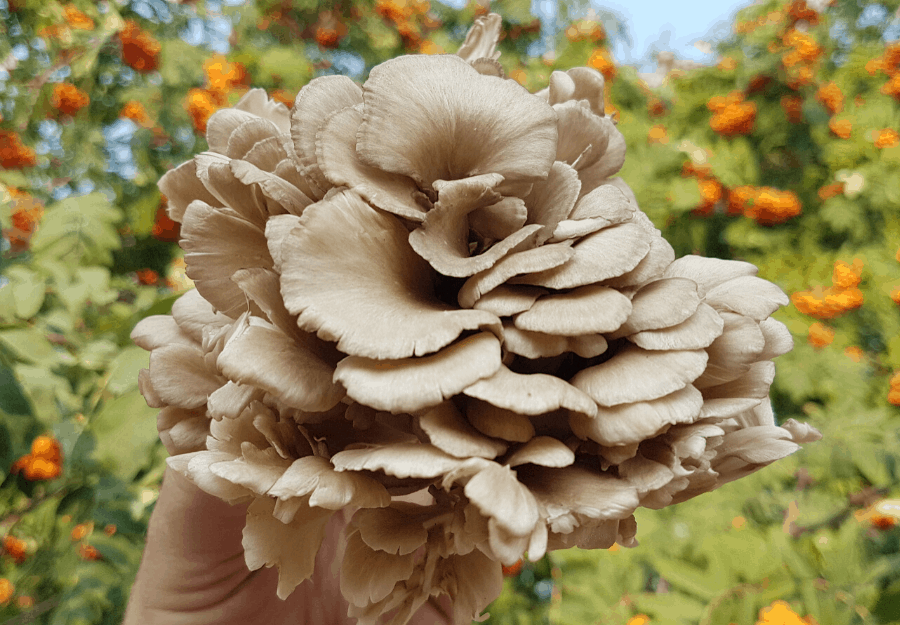
Maitake is also known as “Hen of the Woods”, or “Sheeps Head”. People use Maitake to:
- Support the immune system
- Treat stomach issues
- Regulate blood sugar levels
- Aid other forms of cancer treatment
Maitake really is complete package.
Not only is it a top-of-the-line gourmet edible (just ask any chef!), it’s also a powerful medicinal superfood that pretty much anyone can benefit from.
Maitake has a high concentration of beneficial beta-d-glucans, which are pulled out of the mushroom fruiting body during hot water extraction.
The polysaccharides have been found to help control blood sugar levels in diabetes patients, which results in a cascade of additional benefits- such as lowering cholesterol, improving blood pressure, and helping with weight management. (5)
This mushroom may also be helpful for cancer treatment. Extractions from Maitake, specifically the polysaccharide known as MD-fraction, were found to provide support to the immune system during chemotherapy. (6)
4. Shiitake (Lentinula edodes)
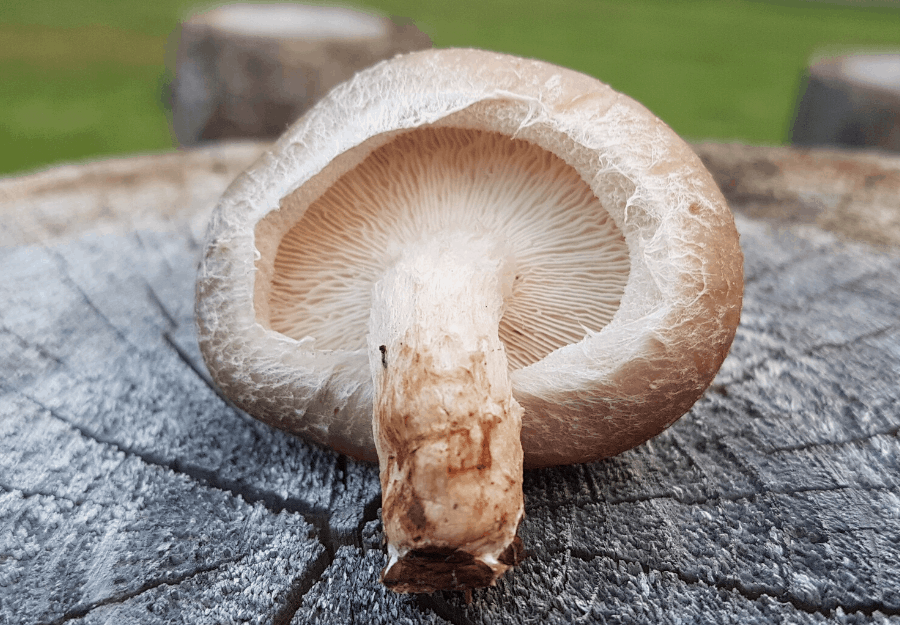
Shiitake is a well-known gourmet mushroom commonly found at the grocery store.
Millions of lbs of Shiitake mushrooms are grown every year, second only to the common button mushroom. Shiitake is popular in Asian cuisine, but is also considered a powerful medicinal mushroom.
Medicinally, Shiitake is used for:
- Beautiful, healthy skin
- Liver support
- Cholesterol control
One highly purified polysaccharide from Shiitake is licensed in Japan as a treatment for gastric cancer. (6)
Through clinical studies, other compounds in Shiitake (eratidenine) show potential for lowering cholesterol levels (7).
5. Turkey Tail (Trametes versicolor)

Also known as Coriolus versicolor, turkey tail is a stunningly beautiful polypore with velvety caps and striations of color. It really does resemble a turkey’s tail.
It is not considered a gourmet mushroom, since it is much too tough to be enjoyed fresh or dried.
Typically, turkey tail is used by making a hot water extraction.
Medicinally, turkey tail is used for supporting the immune system and as an adjunct to traditional cancer treatments. (8)
Turkey Tail contains two notable polysaccharides PSK (Krestin) and PSP (poly-saccharide peptide), which have been studied for boosting immune cell production and improving the outcome of cancer patients. (9)
Turkey Tail is one mushroom that is also commonly used for dogs!
6. Chaga (Inonotus obliquus)
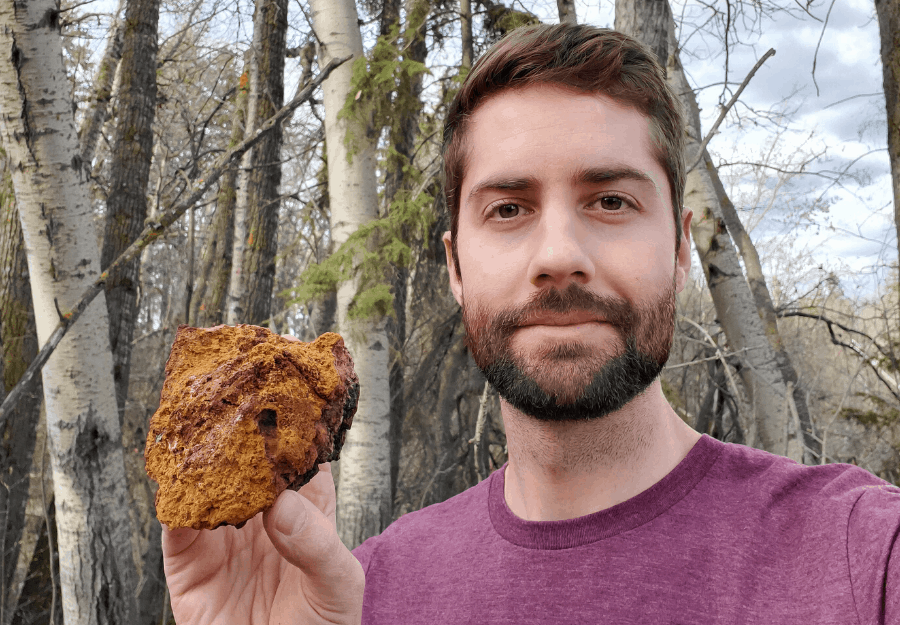
This fungus is a dense source of antioxidants, and is most commonly used for:
- reducing free radical damage
- detoxification
- immune support
- relaxation and stress relief
Chaga is also thought to help with digestive disorders (10) and act as an anti-viral (11).
Believe it or not, true Chaga mushroom is not actually a mushroom- but a “sclerotium” – a mass of Chaga mycelium and wood from the birch trees that it grows on.
It doesn’t really look like a mushroom either. Chaga is parasitic, and grows as a hard black mass on the outside of birch trees. The inside of the mass is lighter brown or orange.
Chaga is much too tough to be eaten. Instead, Chaga needs to be ground into a fine powder and then extracted with hot water, alcohol, or both.
7. Tremella (Tremella fuciformis)

Tremella is considered to be the “beauty mushroom” and is traditionally used for anti-aging and skin health. You may see Tremella in cosmetic applications since compounds in this mushroom are good for moisture retention and skin protection. (12)
Tremella has also been studied for brain health and improving memory impairment. Research in rats has shown the bioactive polysaccharides in Tremella can increase superoxide dismutase activity in the brain and liver, which supports the purported anti-aging benefits. (13)
8. Lion’s Mane (Hericium erinaceus)
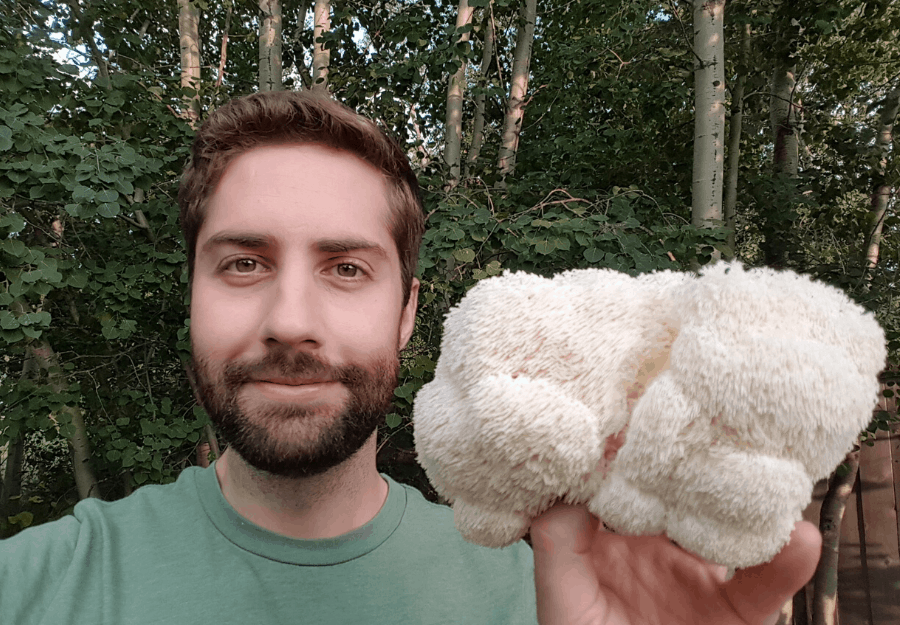
This funny looking mushroom is one of the special ones that is both a delicious culinary mushroom, and a medicinal powerhouse.
In recent years, it has also become one of the most popular mushrooms due to its purported brain boosting benefits.
Lion’s Mane has been shown to stimulate the production of NGF (nerve growth factor) an important compound involved in the growth, maintenance and protection of brain neurons. It also plays an important role in immunity. (14)
Lion’s Mane has also been studied for its potential to reduce symptoms of anxiety and depression. One study showed patients reporting increased feelings of wellbeing from consumption of 2 grams per day. (15)
9. Enoki (Flamulina velutipes)
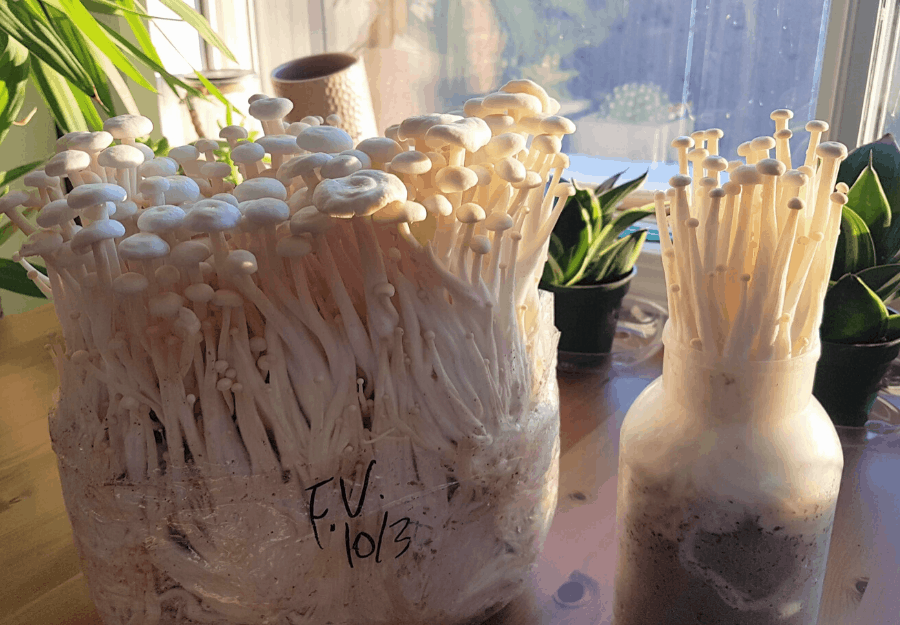
Enoki is one of the most widely cultivated mushrooms in the world, with over 2.7 billion kgs grown annually, mostly in China. Enoki is mostly considered a culinary mushroom, but it also has some interesting medicinal qualities.
Notably, Enoki has been studied for its potential as an anti-cancer (16), anti-viral (17) and its potential to improve allergic response. (18)
Supplement Types
“Extraction method, fruiting body, mycelium on grain?!?! I thought mushrooms were just mushrooms?”
The world of mushroom supplements can be confusing to newcomers.
That’s because there are so many different methods to make them, and different methods to take them. Even worse, many supplement manufacturers aren’t upfront about what it is they are selling.
Without a doubt, it can be a little overwhelming when just learning about it all. How are you supposed to know what’s right for you?
The truth is, different things work for different people- and it really is the efficacy of the product that matters most. So- if you decide to use a mushroom supplement, you should probably know exactly what it is that you are taking.
The two most important things to understand are:
- How the mushrooms are produced (if at all)
- What extraction method is used (if any)
Production Methods
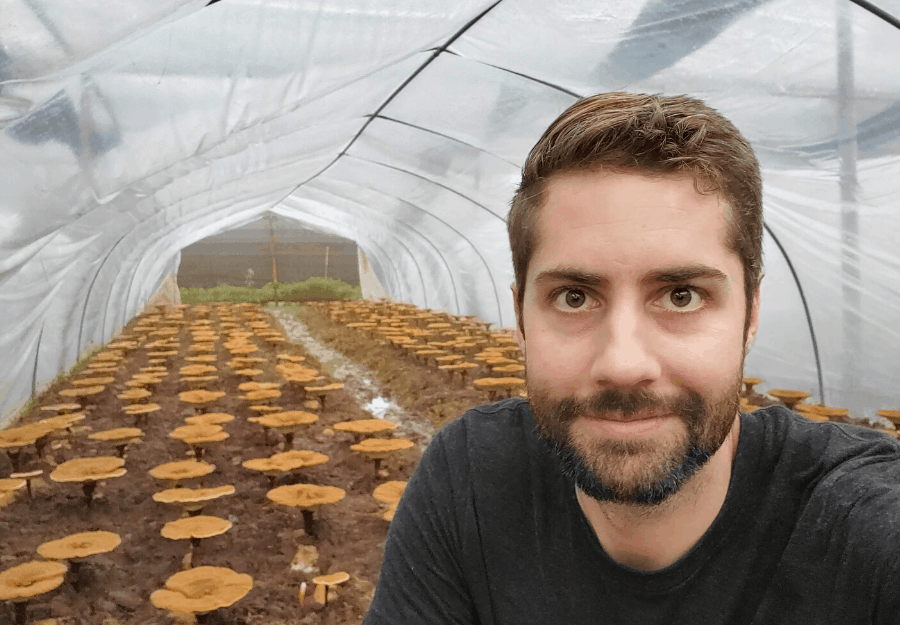
Whole Fruiting Body
The term “Whole fruiting body” refers to what most people think of when they think of mushrooms.
It’s the actual “mushroom” that grows out of the tree, log, or stump- and likely what you’d expect most mushroom supplements would be made from.
The fruiting body contains the highest concentration of active compounds that give functional mushrooms their beneficial properties. Traditionally, this is the part of the mushroom that has been used for functional purposes.
Before lab cultivation was possible, medical practitioners would harvest fruiting bodies from the wild, and use them to make a tea.
The problem is, growing mushroom fruitbodies is quite expensive to do. To be economically viable for commercial use, they need to be grown by experts at huge scale.
Luckily, there are expert growers overseas (mainly in China) that have been organically growing mushrooms for hundreds of years- and know how to produce a high-quality product.
In fact, China produces over 85% of the world’s mushrooms, and virtually any “whole fruiting body” mushroom product originates in that country. They truly are the world’s leading experts in quality mushroom cultivation.
Myceliated Grain
The other part of the mushroom is known as “mycelium”, and some people refer to it as the “roots” of the mushroom. It’s a white stringy substance that expands relentlessly looking for nutrients, until it decides to produce an actual mushroom.
You can kind of think of it like an apple tree. If the “fruiting body” is the apple, then the “mycelium” would be the rest of the tree. Of course, we generally would prefer to consume the apple!
If you ever want to see mycelium, peel back some moss, or dig about an inch into the ground next time you are in the woods. You’ll almost certainly see the thin threads of mycelium spreading across the forest floor.
Mycelium can also propagate rapidly under sterile conditions in the laboratory. Some manufacturers have taken advantage of this by producing huge quantities of mycelium that has been grown on wheat, oats, rye, sorghum, brown rice, or other grain. The grain starch provides a perfect nutrition for fast mycelial growth.
This is why you sometimes see the term “mycelium on grain” when researching mushroom supplements. It means the product was made from mycelium that has grown out on grain, and no actual mushrooms were fruited.
This is a much cheaper method of production and is the reason why it can be feasibly produced in the USA. These “USA Grown” mushrooms are almost always mycelium on grain, unless done in really small quantities. That is why you’ll see things like “myceliated brown rice” or “myceliated oats” on the ingredient list.
These powders will also taste and smell the same no matter which “mushroom” was used. That is because the vast majority of the final product is just grain starch, containing very little actual beneficial compounds. Typically, the level of beta-d glucans will not be listed on the packaging.
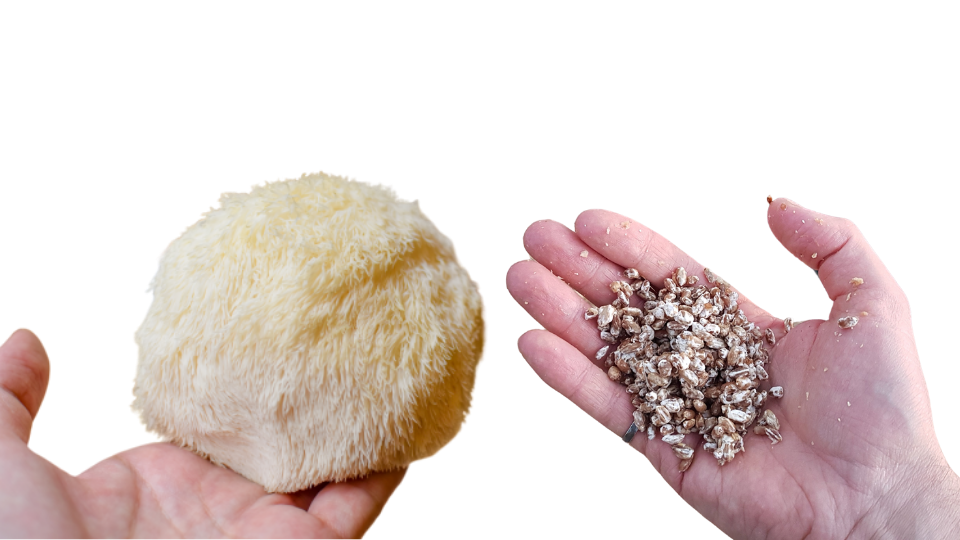
Full Spectrum
The term “full spectrum” is more of a marketing term.
It seems to mean that the whole mushroom organism is used- fruiting body and mycelium. The problem is, it is not clear what is actually meant by this term- and even some manufacturers seem to use the term without really explaining what they mean by it.
Pure Mycelium
Mycelium doesn’t necessarily have to be grown on grain. It can also be grown in “liquid culture”, large vats of nutrient rich liquid. The mycelium floats in suspension, and happily grows through the liquid.
This pure mycelium can be filtered from the liquid, dried, and turned into a mushroom supplement. The result is a highly concentrated form of mushroom mycelium, without any additional starchy fillers you get with mycelium on grain.
It sometimes makes sense to do this. For example, some mushrooms are difficult or impossible to grow, even though the mycelium is easy to propagate in liquid.
Cordyceps sinensis is one of these mushrooms. In nature, it grows on insects, and so far has evaded attempts at cultivation. The mycelium from one strain of cordyceps, “CS-4” has been shown to have similar beneficial properties as the mushroom itself. Growing it in liquid culture allows for easy propagation of the mushroom without adding unnecessary fillers like grain.
Spores and Spore Oil
Instead of seeds, mushrooms use spores to reproduce. The spores are almost always released from the gills or pores on the underside of the mushroom fruit body. If processed correctly, these spores can have remarkable beneficial properties.
A common mushroom type that spores are harvested from is the Reishi mushroom. The spores are typically collected by placing a cardboard tube around the fruit body when it is ready to release spores. Once collected, the spores are “cracked” by heating, or by forcing through polished rollers. This makes the beneficial compounds bio-available.
Cracked spores can be purchased in pure powder form, but sometimes you’ll see them suspended in oil and sold as “spore oil”.
Extraction Methods

The beneficial compounds in mushrooms- such as the beta-d glucans, triterpenes, and sterols are not easily absorbed by our body. This is because they are “locked” in the cell walls of the mushroom fruit body, and our body chemistry is not set up to properly process this tough material.
It’s the same reason as to why we eat lots of plants for fiber- our body cannot properly break it down, so it provides roughage for our digestive system.
In order to be most effective, mushrooms need to go through an extraction process. This is typically done by hot water extraction or alcohol extraction. In some cases, these processes are done in sequence, producing a product that is dual-extracted.
Extraction method is important, because it determines which compounds are most bio-available.
Hot Water Extraction
Hot water extraction is the traditional method of processing medicinal mushrooms. That is because one of the most heavily studied and important compounds in mushrooms is water soluble. This compound is beta-d glucan, a very special type of polysaccharide that has immunomodulating properties.
Before modern processing facilities, hot water extraction would be made by simply making a tea. The mushrooms were sometimes ground into powder or torn into many pieces to provide more surface area for extraction. They were then steeped in hot water for several hours to make the tea.
Today, the same process takes place, but on a much larger scale. Mushroom fruitbodies are simmered in hot water for several hours. Since a liquid is not a great method of distribution, the extract is usually “spray dried” and turned into a fine powder which can be encapsulated or added to food, tea, coffee, or smoothies by the end consumer without the need for further processing.
Alcohol Extraction
Some compounds such as triterpenes and sterols- are not soluble in water. In order to make them more bio-available, an alcohol extraction should be performed.
The mushrooms are soaked in large vats of alcohol, and then the liquid is dried into a fine powder. Alcohol extracts are sometimes also sold as a tincture. There is some concern that alcohol extraction can actually denature some of the other beneficial compounds and may not be as effective as aqueous extracts.
More research on the effectiveness of the different methods still needs to be done.
Dual Extraction
Dual extraction is done by performing both a hot water extraction and an alcohol extraction- and then combining the final product. It can be sold as a powder or as a tincture.
Sometimes it is done by two separate processes, and then combined. Other times, the extraction can be performed using a water/alcohol mix in one step.
Dual extracted supplements make all the beneficial compounds in medicinal mushrooms bio-available, but there are some drawbacks. The main concern is that these dual extracted powders will actually contain fewer beneficial beta-d glucans than hot water extracts alone.
What About Extraction Ratio?
Often, medicinal mushroom products will also highlight the level of concentration. You’ll see things like 1:1, 8:1 etc.
Be careful though, because these concentrations are sometimes dubious claims (100:1??) made to make it seem like the product is more powerful or concentrated- and might not be true.
All this ratio means is how much actual mushroom product was used to make the final product. A 1:1 extract ratio means that 1 lb of mushrooms was used to make 1 lb of extract. An 8:1 would mean that 8 lbs of mushroom fruit body was used to make 1 lb of extract. Poor processing methods will usually lead to higher extraction ratio, solely because the extraction is less efficient.
Hot water extraction will always attempt to get as much of the beneficial compounds out of the mushroom as possible, which will be different depending on the mushroom.
Reishi, for example, has a hard fruitbody and not that much material can be extracted into hot water. That is why Reshi has a natural hot water extraction ratio of around 16:1.
Lion’s Mane, which has a natural extraction ratio of around 4:1, has a much softer fruit body.
It is more important that the supplement facts table actually lists the percentage of active compounds in the product, which can be tested for after extraction.
Beneficial Compounds

Of course, behind the “magic” of these medicinal mushrooms are the beneficial compounds, the actual molecules that interact with the cells in your body and make it all happen.
There are an incredible array of compounds that can be found in functional mushrooms- and more research is being done all the time. Even within these sub-groups of compounds, each mushroom species can produce molecules with slightly different shapes, which affect our systems in different ways.
That’s why different mushrooms seem to have their very own “superpower”, or different beneficial effect it can have on our health.
1. Beta-D Glucans
Beta-glucans are some of the most well known and well studied compounds in mushrooms. It’s also easy to test for the presence of fungal beta-glucans in mushroom extracts, and you will often see it printed in the nutrition facts of any mushroom supplement.
Beta-d glucans are polysaccharides- molecules made up of long chains of sugars. These molecules are immunomodulators, and can support both overactive and underactive immune systems.
2. Sterols
Mushrooms also contain a variety of sterols, the most commonly studied being ergosterol. Ergosterol extractions have been studied for anti-tumor activity, (ref) and are thought to have anti-aging activity.
When exposed to UV light, ergosterol is converted into vitamin D2. That is why some commercial mushrooms are treated with UV light before being sold in the supermarket.
3. Terpenoids
Terpenoids are fat-soluble compounds that are studied for their antiviral and antibacterial abilities. They are also thought to be powerful anti-inflammatory agents.
How To Take Mushrooms
There are a whole whack of different ways to take your functional mushrooms, with each one having its own advantages and disadvantages.
What’s right for you might not be right for someone else.
That being said, it’s important to understand what options you have to choose from, so you can choose what works for you.
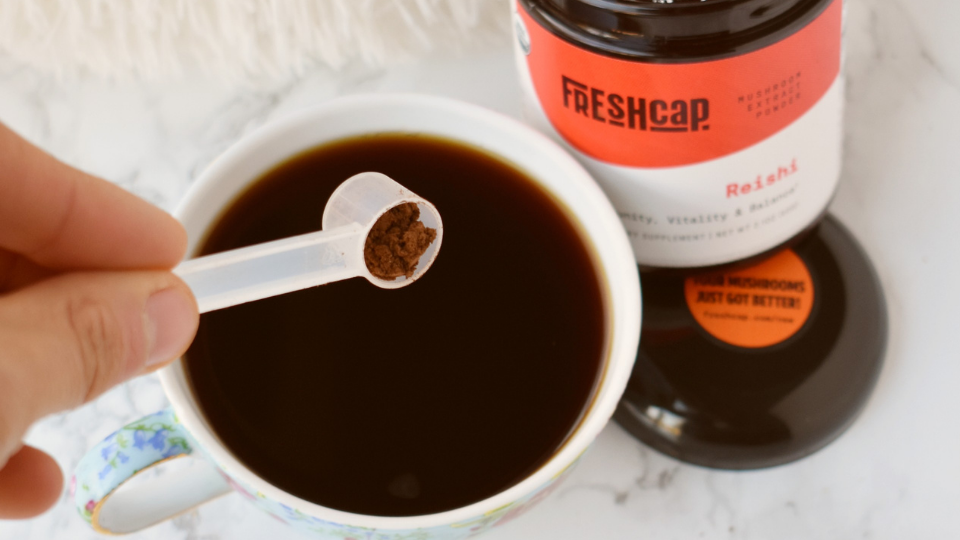
1. Extract Powders
Extract powders are one of the purest, most versatile, and most effective ways to take medicinal mushrooms. They are also usually the most economical- giving you the most benefits for your buck.
These powders are available in a variety of different species, and are produced using either alcohol extraction, water extraction, or both.
They are easy to add to coffee, tea, smoothies, or any other foods. Many functional mushrooms have a neutral or “earthy” flavour and are easily palatable. Some species, like Cordyceps or Reishi, can have very distinct flavors that can be off putting for people with sensitive pallets. Still, the flavour can be easily masked in smoothies or other foods.
Extract powders also make it easy for your to titrate your dose, and mix whatever combination of mushrooms suits you best. Some people like to “stack” certain species together, and these powders make it perfectly easy to do that.
2. Capsules
Capsules can be another great option for you to get your mushrooms!
Capsules are convenient, require no extra preparation, and are easy to travel with. This is great, since travelling is when you need your immune system to be in top shape.
The highest quality capsules will contain nothing but pure mushroom extract powder. Often, fillers or “flow aids” will be used to make the manufacturing process easier. If you can avoid using capsules with extra ingredients, it is probably worth it.
You should also consider what the capsule shell is made from. Look for natural capsules, with veggie caps or “pullulan” capsules being the best option.
3. Tinctures
You can also use tinctures, which are simply a dropper bottle of liquid mushroom extract.
You will often see alcohol extractions or dual extractions in tincture form. Tinctures are easy to use and easy to control the dose.
4. Whole Fresh Mushrooms
Some mushrooms, like Lion’s Mane or Oyster have both culinary and medicinal value.
They are great additions to many dishes!
That being said, without proper extraction, you are less likely to get the full medicinal value of these mushrooms.
Mushrooms should not be eaten raw since they have tough cell walls that our bodies cannot properly break down.
5. Dried Mushrooms
Many mushrooms can also be purchased dried, and dried fruiting bodies are what are used as raw ingredients to prepare mushroom extract powders.
The best way to use dried mushrooms is to prepare a hot water extraction by making a tea.
You can also make an alcohol or dual extraction by soaking the fruiting bodies in alcohol for a number of days.
Simply ingesting dried mushrooms (in whole form or powder) will not give the maximum health benefit, since the beneficial compounds will not be bio-available.
6. Mushroom Infused Products
Mushroom coffee, mushroom protein powder, mushroom collagen, mushroom elixirs, the list goes on and on.
There are more ways than ever to get mushrooms in your life!
Just make sure that the products actually contain efficacious doses of mushrooms, and that the mushrooms are properly extracted and prepared so you can get the maximum benefit.
7. Stacking Mushrooms with Other Products
Many people will “stack” mushrooms with other products. For example, adding mushrooms to coffee, making your own mushroom elixirs with other superfood powders, the list is really endless.
If you want some inspiration, check out our delicious mushroom extract recipes.
Best Time to Take Mushrooms
There is a lot of talk about the best time to take medicinal mushrooms.
In general though, it doesn’t seem to matter what time of day mushrooms are used. The major benefits of mushrooms act over longer periods of time and consistent use, no matter the time of day.
Some mushrooms, however, can have acute sedative or energizing effects for some, and so it makes sense to at least consider if this is going to be a concern for you.
Reishi is an example of a mushroom that can have more acute effects. It is often used as a sleep aid, or put made into a relaxing tonic to help people relax in the evening. That being said, it is unlikely to cause drowsiness if taken in the morning or afternoon.
Cordyceps, on the other hand, has an energizing effect, which seems to be much more common. Some people experience it similar to caffeine. For this reason, it is best to avoid Cordyceps at night so that it won’t affect your sleep. Of course, not everyone reacts the same way- so it might not make a difference for you.
Lion’s Mane has benefits for cognitive function, creativity and mental clarity. For some, this is acute- meaning they can feel the difference right away. For others, the effects take prolonged and consistent use to notice an effect. If Lion’s Mane helps you focus in the short term, it makes sense to take it when you need to concentrate or be creative. Maybe putting some in your coffee when you need to work on a big report or assignment.
Mushroom Extract Dose
The proper species and dose will vary wildly depending on what you are trying to achieve.
In general, if you are looking to treat a specific condition, it is best to reach out to a medical doctor or other health practitioner that can assess your specific needs and offer a program that works for you.
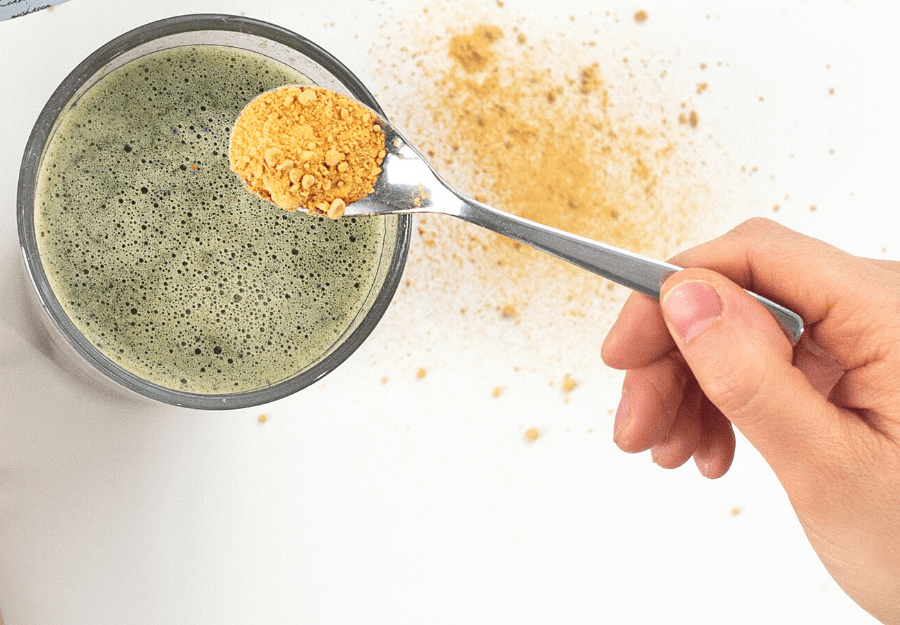
Maintenance Dose for Healthy People
For healthy people just looking to benefit from the immune boosting, cognitive boosting, or energy boosting benefits of mushrooms, a good dose is in the range of 1-2 grams per day.
For our hot water extracts, we recommend 1 gram per day as a good dose. This can be increased or decreased depending on what is working for you.
Higher Doses for Specific Conditions
As mentioned above, specific conditions typically require higher doses for maximum effectiveness.
This can be in the range of 3 grams to even up to 9 grams per day. If you are considering using this level of dose, you are best to consult with a natural health practitioner or other medical professional.
Side Effects of Mushrooms
Mushrooms are generally recognized as safe, which means that they are not likely to cause harm when used as intended.
That being said, it is possible for certain individuals to have adverse reactions, or even allergic responses to medicinal mushrooms.
As with any health product or new substance, it is best to introduce it slowly to ensure you are not one of the rare individuals that react negatively to mushroom extracts.


Impressive write up. When is your book coming out?
Happy New Year 👊
Thanks Brian!! Maybe one day I’ll get a book together haha. Thanks for checking in! Happy new year to you too 🙂
Great information thank you for the education and read 😊
Glad you like it, thanks for checking it out 🙂
I enjoyed reading about mushrooms learned a lot Thank you for the great read
Glad you liked it! Thanks for your comment 🙂
I personally have a BIG jar of Chaga that my brother brought to me from Minnesota I have been drinking 2 glasses of the tea everyday for the last 6 weeks and went for my blood tests and lowered my husbands A1c for his diabetes.
That’s amazing, thanks for sharing!
we find them freely and this mushroom is responsible that I am OFF Insuline
.
So what I’d really like to know, but dont see covered here, is which supplement companies are most reputable and rigorously tested? I’m specifically interested in cordyceps…
Great article!
Personally, I like powders because it’s easy. I love adding them to my morning coffee or smoothie after I workout,
Stay safe and healthy!
Cheers!
I really enjoyed this article! I didn’t know mushrooms were so fascinating and their health properties! Was looking for lowering estrogen levels in my body and wound up reading this whole article!
Thank you so Much
I truly appreciate the information I found on this site.
I had just started to use mushroom powder to treat my patients, and they
are getting recoveries.